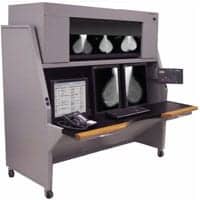Local, State, Federal
Connecticut Breast Density Law Raises Questions
In October 2009, the state of Connecticut passed a law mandating that a mammography patient?s breast density rating be included on the report to their physician; if the breast density is rated as high, a suggestion for further screening is also included. This new law presents a number of potential implications for patients and radiologists in Connecticut and across the United States.
Currently, under the Mammography Quality Standards Act (MQSA), radiologists are required to notify patients in writing of their mammography results, written in terms that the patient can readily understand. In Connecticut?s recently passed law, all patients must also be informed of their breast density rating in the written mammography report. For patients with very dense breast tissue, the law requires a statement to be included with results, explaining how dense breast tissue could hide small abnormalities and that supplementary screening tests (such as breast ultrasound screening or breast MRI examination) may be beneficial.

The intent of the Connecticut law is to let women with highly dense breasts know that their mammogram is normal, but that the mammogram results alone should not be relied upon as much as a normal result for women with lower breast density. This information is more than women have typically received about their mammogram. How this information may be used and how patients may benefit remain to be determined.
Connecticut uses the American College of Radiology?s Breast Imaging Reporting and Data System (BIRADS) rating to report the density of breast tissue. When asked about the accuracy of such breast density ratings, Carol H. Lee, MD, chair of the ACR Breast Imaging Commission, stated, ?In BIRADS, there are four categories of breast density that you can describe, but those categories are very subjective. ? So I can imagine a woman being told one year that she has dense breasts and another year being told she doesn?t have dense breasts. I think that is a potential problem.? Lee went on to say that she suspects there may be an increase in the number of ultrasound screenings and biopsies.
?Younger women tend to have denser breasts than older women. So the women who are going to get supplemental screening with ultrasound will probably be, by and large, young? added Lee.
In women with very dense breast tissue, the ability to pick up cancers with mammography is decreased. The question is: How important is it to find early or small breast cancers in this population? ?We will have to wait and see what the numbers show, and it?s going to take a while before we collect enough information before we know whether this is or is not a good thing,? said Lee.
In the January 2010 issue of the Journal of the American College of Radiology, the ACR published a statement regarding the use of ultrasound for screening in addition to mammography for women at increased risk. The statement lists the disadvantages associated with screening ultrasound, such as reproducibility, high false-positive rates, low positive predictive value for biopsy recommendations, and operator dependency of the examination, to name a few. It states, ?Because of the demonstrated superior sensitivity of breast MRI for screening high-risk women, the disadvantages associated with screening ultrasound, and constraints of a limited number of radiologists who perform breast imaging, many facilities have chosen not to offer ultrasound screening. The ACR and SBI consider such a choice to be acceptable within the standard of care.?
Lee commented, ?If it turns out that Connecticut is finding a whole lot of otherwise undetected cancers and that their biopsy rate and false-positive rates are within an acceptable range, certainly this might be something that the college may consider [supporting]. But right now, based on the evidence that we have to date, we did include in our screening statement that screening ultrasound is something that could be considered for women at high risk with dense breasts.?
?Carol Dawson
Carol Dawson is a contributing writer for Axis Imaging News.





